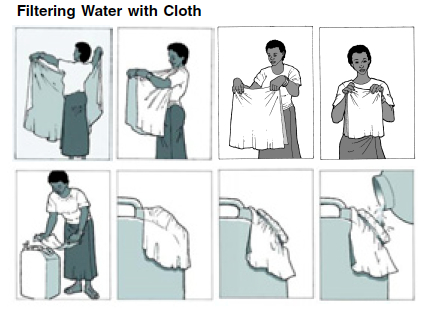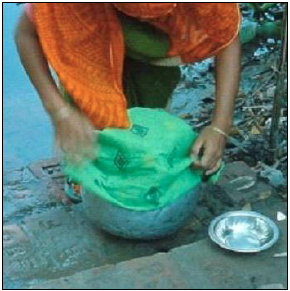Difference between revisions of "Straining (fabric or micro)"
(→Acknowledgements) |
|||
| Line 1: | Line 1: | ||
[[Image:straining icon.png|right]] | [[Image:straining icon.png|right]] | ||
[[Image:straining with cloth.jpg|thumb|right|250px|A woman uses a sari cloth to strain water. Photo: CAWST.]] | [[Image:straining with cloth.jpg|thumb|right|250px|A woman uses a sari cloth to strain water. Photo: CAWST.]] | ||
| − | + | [[Image:cloth filtering.jpg|thumb|right|600px|The steps of filtering water through a cloth. Diagram: CARE/CDC Health Initiative, etc. from [http://www.cdc.gov/safewater/manual/sws_manual.pdf Safe ProjectsSafe Water Systems for theDeveloping World:A Handbook for ImplementingHousehold-Based Water Treatmentand Safe Storage ProjectsEstes.]]] | |
| − | [[Image:cloth filtering.jpg|thumb|right|600px|The steps of filtering water through a cloth. Diagram: CARE/CDC Health Initiative, etc. from [http://www | + | __NOTOC__ |
| − | |||
Straining water through a cloth has been widely used for household water treatment in many cultures for centuries. A common sari cloth is usually used for this in South Asia, for example (photo on right). Straining through a fine cloth can take out guinea-worm, organic matter, and help clear up turbidity. Such cloths are effective in straining out the copepods in the water. These tiny water creatures act as intermediate hosts for the larvae which transmit the disease. Some guinea-worm eradication projects supply a large-diameter drinkingstraw with a filter mesh on one end so that | Straining water through a cloth has been widely used for household water treatment in many cultures for centuries. A common sari cloth is usually used for this in South Asia, for example (photo on right). Straining through a fine cloth can take out guinea-worm, organic matter, and help clear up turbidity. Such cloths are effective in straining out the copepods in the water. These tiny water creatures act as intermediate hosts for the larvae which transmit the disease. Some guinea-worm eradication projects supply a large-diameter drinkingstraw with a filter mesh on one end so that | ||
copepods are strained out when water is sucked up the straw. | copepods are strained out when water is sucked up the straw. | ||
Revision as of 04:08, 13 December 2012

Straining water through a cloth has been widely used for household water treatment in many cultures for centuries. A common sari cloth is usually used for this in South Asia, for example (photo on right). Straining through a fine cloth can take out guinea-worm, organic matter, and help clear up turbidity. Such cloths are effective in straining out the copepods in the water. These tiny water creatures act as intermediate hosts for the larvae which transmit the disease. Some guinea-worm eradication projects supply a large-diameter drinkingstraw with a filter mesh on one end so that copepods are strained out when water is sucked up the straw.
Monofilament nylon cloth has been found to be more effective in straining out the vector - various species of the small crustacean, cyclops - than local cotton cloth, though the former one is more expensive.
The pore size range in old (laundered) sari cloth is 100–150 μm, but about 20 μm if the cloth is folded four to eight times. The holes allow water to pass but retain particles and pathogens >20 μm. Straining through sari cloth has been shown to be effective in filtering out the plankton to which cholera bacteria may attach themselves, therefore reducing the risk of cholera. This simple method can also filter out many helminths and their eggs and larvae.
Old sari cloth made of cotton was found to be most effective in removing cholera based on laboratory experiments. After several launderings, threads of an old sari become soft and loose, reducing the pore size, compared with new sari cloth.
Suitable conditions
Cloth is available around the world, discarded cloth may be used.
Construction, operations and maintenance
Fold a large, clean piece of cloth seven to eight times. Place the folded cloth over a clean water container, and secure in place. Pour water through the cloth into the container. Wash the cloth in clean water before using it again.
Cloth may need to be replaced if there are holes.
Cloth needs to be washed in clean water after every use.
Manuals, videos, and links
- Manual that includes micro-filtration: MCALLISTER, SKYE. EPD 397 TECHNICAL REPORT ANALYSIS AND COMPARISON OF SUSTAINABLE WATER FILTERS. May 2005.
- Straining using a slow sand filter with a cloth filter: Oxfam Water Supply Scheme for Emergencies.
Acknowledgements
- Household Water Treatment and Safe Storage Fact Sheet: Straining. CAWST. Calgary, Alberta, Canada.
- Brikke, François, and Bredero, Maarten. Linking technology choice with operation and maintenance in the context of community water supply and sanitation: A reference document for planners and project staff or (alternative link). World Health Organization and IRC Water and Sanitation Centre. Geneva, Switzerland 2003.
- 58. Household water treatment I or (alternative link). WATER AND ENVIRONMENTAL HEALTH AT LONDON AND LOUGHBOROUGH (WELL).
- Acceptance and use of communal filtration units in guinea worm eradication. Tropical Medicine and International Health, January 2000.

